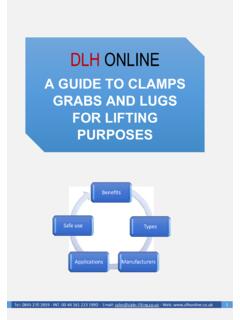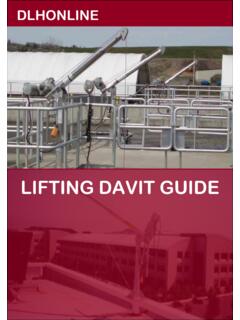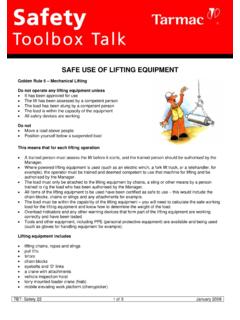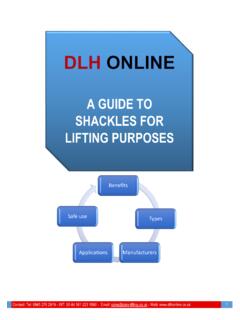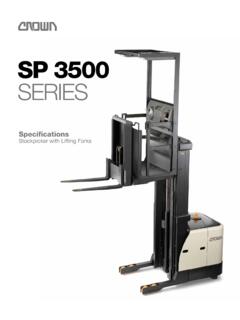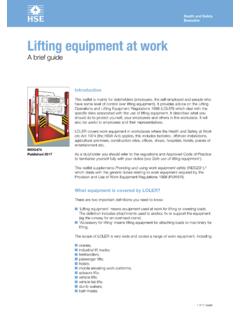Transcription of GUIDE TO LIFTING BEAMS AND LIFTING SPREADERS
1 A comprehensive GUIDE for specifiers, buyers, and responsible persons SelectionDesignManufactureVerificationSa fe use ONLINE A GUIDE TO LIFTING BEAMS AND SPREADERS Tel: 0845 270 2919 - INT: 00 44 161 223 1990 - Email: - Web: 1 Overview This easy-to-read and comprehensive GUIDE to LIFTING BEAMS and SPREADERS contains information extracted from the LEEA guidance - The verification of spreader BEAMS , LIFTING BEAMS and LIFTING frames. It covers all aspects of the selection, design, manufacture, verification, testing, repair, modification, storage, inspection and safe use of LIFTING BEAMS and spreader BEAMS . The table of contents (Next page) lists the sections covered and contains links to each section. For ease of use, each section is linked back to the table of contents.
2 Tel: 0845 270 2919 - INT: 00 44 161 223 1990 - Email: - Web: 2 Table of contents Sections Title Page 1 Why use a LIFTING beam? 3 2 LIFTING beam v LIFTING spreader 4 3 Variations 5 4 Making sure the load is stable 6 5 Multi-purpose designs 9 6 Standards for LIFTING BEAMS and SPREADERS 10 7 Documentation 11 8 Design standard 12 9 Technical file 12 10 Verification methods 14 11 Verification through calculation 15 12 Verification through test 17 13 Load testing with weights 18 14 Load testing by means of an applied force 19 15 Verification of LIFTING beam with moving parts 20 16 Verification of ancillary items 22 17 Attaching the LIFTING beam to the crane and load 23 18 Beam markings and identification 24 19 Markings 25 20 Considerations for headroom 26 21 Storage 27 22 Instructions for safe use and maintenance 28 23 In-service inspection of LIFTING BEAMS 29 24 Verification of repairs and modifications 30 25 Our
3 Services 32 Contacting us 33 Tel: 0845 270 2919 - INT: 00 44 161 223 1990 - Email: - Web: 3 1. Why use a LIFTING beam? LIFTING BEAMS , frames and SPREADERS are usually designed and built for a specific purpose. The range of designs and capacities is therefore only limited by practicality. It is important to take care in selecting the right type of beam to be used and to plan the lift taking the following into account: Application requirements - to reduce headroom, provide multiple LIFTING points, to provide adjustable LIFTING centres, to handle out of balance loads, to remove or control inward or crushing forces, to allow for special load attachments. Calculations to be made will include the capacity, both of the overall beam and of the loading of the individual LIFTING points.
4 Another important consideration is the centre of gravity of the load to be lifted, together with any accessories and or attachments used - slings, grabs, shackles, hooks, magnets, vacuum pads etc. (Back to table of contents) Tel: 0845 270 2919 - INT: 00 44 161 223 1990 - Email: - Web: 4 2. LIFTING beam v LIFTING Spreader LIFTING BEAMS , LIFTING frames and LIFTING SPREADERS are a means of providing two or more LIFTING points from the hook of the LIFTING machine or crane spaced so as to match the position of the LIFTING points on the load. The difference lies in the way the forces are transmitted. A LIFTING beam is loaded in bending. Typically a simple LIFTING beam will have a single LIFTING eye above the beam which engages with the LIFTING machine hook and lower LIFTING eyes at points on the underside of the beam to connect to the load.
5 A spreader, often called a spreader beam, is actually a strut loaded in compression. Typically a simple spreader will have a suspension sling which connects the LIFTING machine hook to the ends of the spreader which are then connected to the load. This arrangement enables the sling to lift, A cable reel from its axle whilst preventing the sling legs damaging the drum flanges. The design of modern SPREADERS is usually much more sophisticated but the principle is the same. In practice a combination of beam and spreader is often used and whilst the terms are often used interchangeably, the equipment itself is not interchangeable. It must be loaded in the manner for which it was designed. (Back to table of contents) Tel: 0845 270 2919 - INT: 00 44 161 223 1990 - Email: - Web: 5 3.
6 Variations Another variation of the LIFTING beam is one designed to connect two overhead travelling cranes and provide one or more LIFTING points. This facilitates tandem LIFTING . The total LIFTING capacity can be that of the two cranes less the self-weight of the beam and any allowance for uncertainty in the sharing of the load. Most LIFTING BEAMS and SPREADERS will be designed for specific applications A LIFTING beam for use with vacuum pads or LIFTING magnets to lift long flexible loads which needs support at regular intervals to prevent sagging. A spreader might be designed to lift a load such as a vehicle or boat, LIFTING it from the base but keeping the slings clear of easily damaged areas. Tel: 0845 270 2919 - INT: 00 44 161 223 1990 - Email: - Web: 6 4. Making sure the load is stable LIFTING BEAMS and SPREADERS are often used when there is limited headroom.
7 Ideally it is best if the attachment points on the load are above its centre of gravity as that will ensure that the load will always hang in a stable position. However if the LIFTING beam or spreader is connected to the load by slings which attach to the load below its centre of gravity, care is needed to ensure that the load will be stable when lifted. A typical application of this kind might be a container lifted from the base. The LIFTING beam is connected to the container base by four vertical single leg slings. When viewed from the side, the LIFTING beam, container and slings form the four sides of a rectangle. Without triangulation the four sides form a mechanism which can deform into the shape of a parallelogram. That is what happens if the load is unstable and starts to topple.
8 (Continued next page) Tel: 0845 270 2919 - INT: 00 44 161 223 1990 - Email: - Web: 7 Looked at from the side, the figure left illustrates the situation. The forces which prevent or cause toppling come from the vertical distance from the seat of the LIFTING machine hook to the sling attachment points on the LIFTING beam (A) and the distance of the centre of gravity above the attachment points on the skid (B). The centre of gravity will always try to be as far from the hook as possible. If (A) is greater than (B) the arrangement will be stable. The larger the difference, the more stable the arrangement will be. However if (B) is greater than (A), the arrangement will be unstable and will topple. The relationship between dimensions (C) and (D) also affect stability.
9 If (C) is greater than (D) the arrangement will be less stable. The issue of stability should be considered at the lift planning stage and not left to checking at the time of rigging. The static friction at the pivot points can be sufficient to allow a well balanced load to be lifted vertically. However when a travel motion is started this can be sufficient to break the frictional grip and, once the load starts to topple, there is no going back. (Continued next page) Tel: 0845 270 2919 - INT: 00 44 161 223 1990 - Email: - Web: 8 The example described is a four point LIFTING arrangement but the same problem can occur with other arrangements. For example a load held by two slings in basket hitch, one at either end connected to a straight LIFTING beam. Viewed end on, the load is held securely with triangulation provided by the basket hitch.
10 However, viewed from the side, there is the rectangular mechanism supporting the load from below the centre of gravity with only the friction between the slings and the load to stabilise it. LIFTING BEAMS often have a profiled plate eye to engage with the LIFTING machine hook. This keeps dimension (A) to a minimum but can cause stability problems for these types of applications. The obvious way to ensure stability is for dimension (A) to be significantly greater than (B) and this is where a spreader, suspended by a sling, often has the advantage over a LIFTING beam. Alternatively the combination design previously referred to can be used. In this the beam is suspended from a sling connected part way along the beam rather than at the ends. It increases the (A) dimension and the forces in the beam are a combination of bending and compression.

